p.56
p.62
p.67
p.73
p.79
p.85
p.91
p.97
p.103
Investigation on the Flash Butt Welding of 51CrV4 Steels for Saw Blades
Abstract:
The band saw steel must present a good balance between strength, toughness and materials elasticity in the weld joint, respectively in the HAZ. Those areas are affected by the heat welding cycle that is changing the material microstructure and consequently the overall mechanical properties of the saw blade. Minor changes in the chemical compositions of the saw blade material, in welding parameters or in the post-welding treatment can cause semnificative changes in the saw blade durability and performance. A SMEs from Cluj-Napoca had encountered a problem after the welding operation of the 51CrV4 QT steels, bought from two different European manufacturers. It was observed a different welding behavior for the same steel bought from one of the steel manufacturer compared to the other one. The SMEs requested a study in order to find out what went wrong during welding operation, because the bending test has shown an insufficient toughness in the welded joint. As result, we have conducted a research in the quest of the causes for the embrittlement phenomena observed in the welded joint. Chemical analysis, mechanical testing, SEM and EDX and XRD analysis have been used to investigate the material properties in the parent material, weld and HAZ.
Info:
Periodical:
Pages:
79-84
Citation:
Online since:
July 2015
Authors:
Keywords:
Price:
Сopyright:
© 2015 Trans Tech Publications Ltd. All Rights Reserved
Share:
Citation:


